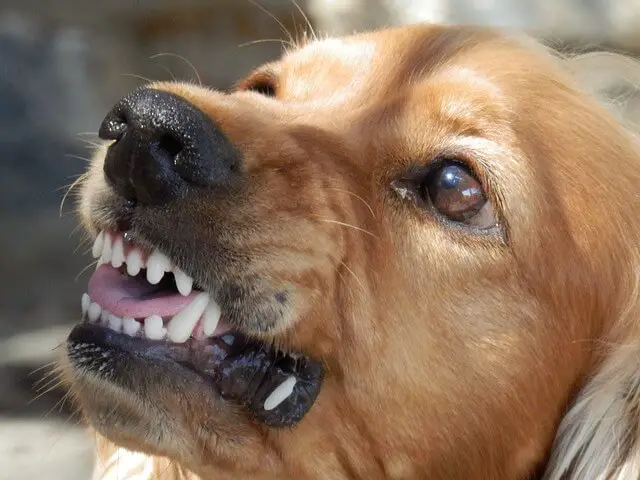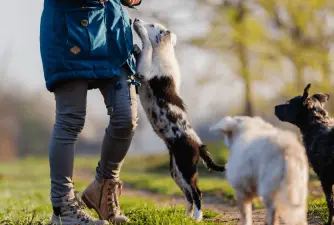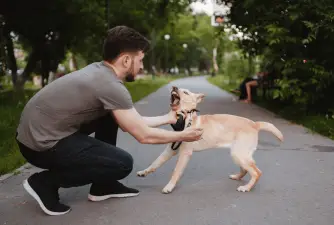Dog Aggression - Signs, Reasons & Training Tips
23.04.2023.
Aggression in dogs is a topic among many dog owners, and this can be challenging and potentially dangerous for many pet owners, especially the ones that own so-called "dangerous" dogs. However, with the right knowledge and approach, managing and even preventing aggressive behavior in dogs is possible.
To help you better understand aggression in dogs, we decided to write tips for you on how to properly approach training the aggressive dog, as well as all the things you must take into account.
Dog aggression training is complex; hiring a professional to help you along the way is advised for first-time and inexperienced dog owners. Only that way can you ensure that you will do it right.
Signs of aggression in dogs
Aggression in dogs can manifest in many different ways and forms, and dog owners need to recognize these things to start correcting this dog behavior.
Some common signs of aggression in dogs include
- Growling and snarling
- Baring teeth
- Snapping or biting
- Lunging or charging at people or other animals
- Dominance displays, such as mounting or standing over other dogs
- Rigid body posture and staring
- Stiff hair
- Ears pinned back
Dogs' body language can tell you many things about your dog and how he is feeling in certain situations. If you manage to notice these signs of aggression, you will be able to help your dog and potentially stop unwanted attacks from your dog.

RELATED: Is There a Thing as an Aggressive Dog
What are the reasons for aggression in dogs?
There could be various reasons why your dog could show aggressive behavior. Some of the most common reasons include
- Fear or anxiety
- Pain or discomfort due to injury or illness
- Territoriality or protectiveness over resources (food, toys, etc.)
- Dominance or social status issues
- Frustration or stress
- Improper socialization
- Genetics or breed predisposition
- A history of abuse or neglect
Understanding the main reason behind aggressive behavior with your dog is the main step in dog aggression training.
RELATED: What Are the Most Aggressive Dog Breeds?
What is a reactive dog?
A reactive dog is one who overreacts to certain stimuli, often seen as barking, growling, or lunging. This can be triggered by various factors, such as the presence of other people, loud noises, or certain things from the environment.
In most cases, reactive dogs are anxious or fearful, and this behavior is a result of their emotional state rather than their ambitions to cause harm. By activity, dogs will try to communicate that they feel un comfort and will want to create a distance from the trigger.

What is the difference between reactive and aggressive dogs?
Differences between reactive and aggressive dogs could be hard to notice for some owners, but there are a lot of differences. Although symptoms and body language could be the same, the intent differs.
Reactive dogs respond to fear, anxiety, or stress and want to distance themselves from what they perceive as a threat. In most cases, reactive dogs will not want to engage in a physical confrontation.
Aggressive dogs are genuinely driven by the intent to cause harm or assert dominance. This could also occur in the event of fear or anxiety, but aggressive dogs are more likely to engage in a physical confrontation and will not want to back down.
Tips for dog aggression training
Managing and correcting aggressive behavior in dogs requires proper patience, consistency, and commitment. These tips could help you if you have to deal with an aggressive dog.
1. Socialization
First, you must ensure that your dog receives proper socialization. Expose your dog to many different people, animals, and environments from an early age to develop confidence and learn how to react in many different situations.
2. Obedience training
From an early age, teach your dog some basic commands to establish control and reinforce positive behavior. Also, you can enroll your dog in obedience training classes, which will also help your dog become calmer and not so aggressive.

3. Positive reinforcements methods
When training your dog, always use positive reinforcement methods because if you are harsh toward your dog, aggression could become even greater. Don't punish your dog for being aggressive; you should find a calmer way to redirect his direction into something positive to calm him down.
4. Redirecting energy
By providing your dog with regular physical and mental activities, you will secure that your dog will be tired and satisfied. If you do so, he is less likely to be aggressive.
5. Proper management
When training your dog, you should use proper equipment such as leashes, muzzles, and others to ensure that your dog is comfortable during the training and protect yourself and other people around you if you own an overly aggressive dog.
When to seek professional help?
Some cases of dog aggression could be too much for certain dog owners to handle, and no matter how hard they try, they cannot control their dogs. This is where you should hire a professional. When searching for a professional to do the job, always look for a certified dog behaviorist or trainer who specializes in dog aggression and who has experience in similar cases.
They will be able to assess your dog, identify the underlying cause of aggression, and make a custom plan for his aggression.

RELATED: What Should You Do If Your Dog Bit Someone?
What you should not do if you have an aggressive dog?
When dealing with aggressive dogs, there are a lot of things that could trigger their aggressive behavior, so you should be alert all the time.
You should never punish your dog or physically correct his behavior because this could also be a trigger, and the aggression could increase. You should always find a calm and non-aggressive way to resolve this problem.
Also, you should be very careful when your dog gets himself into a situation that will trigger his aggression. The best thing you can do is to avoid these situations (of course, if possible) until you figure out how to properly train him and remove aggressive behavior from his life.
You should never ignore the signs of dominant and aggressive behavior, although it doesn't seem to you that your dog is aggressive. These signs could all be the beginning of a greater aggression your dog could exhibit in the future in some other situations.
How to stop aggression in dogs?
While there is no magic trick to stop aggression in dogs, a combination of strategies could be a great way to reduce this behavior until it is completely eliminated. If you are not sure how to do it, don't be afraid to seek help from a professional.
Follow these steps, and you will be able to reduce the aggression in your dog.
1. Identify and address the undelaying cause
You should determine the main problem causing aggression in your dog and work on that. After you figure out what is causing aggression, it will be much easier to address the problem.
2. Consistent training
When you want to eliminate aggressive behavior, you should have consistent training so your dog will understand that aggression is not something wanted. Only by being consistent will you be able to resolve this problem.
3. Manage environment
You should try to remove the triggers from the environment that are causing aggression in your dog. By eliminating triggers, your dog will not need to show aggrieve behavior.

4. Provide proper stimulation
Many causes of dog aggression result from insufficient physical and mental activities. You should provide your dog with plenty of them, especially if you own a highly energetic breed, and this will certainly help with aggression.
It is crucial that you understand how much daily activities does your dog needs. Make sure to read this guide if you want to learn what is the appropriate amount of exercise your dog needs - How Much Exercise Does a Dog Need in a Day
5. Adjust the plan as needed
You should always monitor your dog and adjust the training plan if you notice that something is not working for your dog, and you should start with techniques that do work.
World Dog Finder team







Share